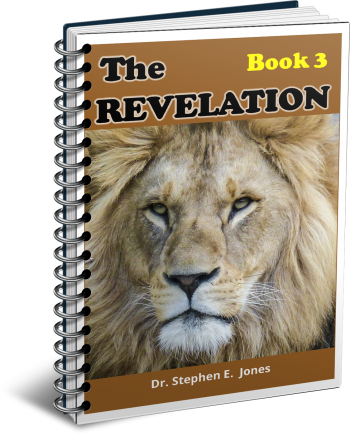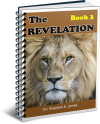Latest Posts
View the latest posts in an easy-to-read list format, with filtering options.

A study of Revelation 6-9. This is book 3 of an 8 part book series.
Category - Bible Commentaries

The sixth chapter of Revelation correlates with the sixth letter of the Hebrew alphabet, the vav, which is a connector. It literally means a nail or peg, something that joins two things. In this case, the fifth and sixth chapters are nailed together (or joined) by a vav.
Of course, the book of Revelation comes to us in Greek, not in Hebrew, so the first word is kai, “And.” But as always, we must think Hebrew, even if the language is Greek, because Greek was being used to express John’s Hebrew thought patterns. In other words, the climactic song of the reconciled creation at the end of chapter five is connected by the vav to the next chapter, where the Lamb opens the book, and John sees the unfolding of events leading to this climax.
In fact, what follows in the rest of the book of Revelation is a continuation of the divine court scene. The Lamb has taken the book and now opens it a step at a time to reveal the events of history recorded in this Book of Creation’s Destiny.
Revelation 6:1 reads,
1 And I saw when the Lamb broke one of the seven seals, and I heard one of the four living creatures saying as with a voice of thunder, “Come.”
The text literally reads, “And I saw when opened the Lamb one of the seven seals.” In other words, when the first seal was broken, the book did not speak words as such, but a picture—a scenario—sprang forth, and John “saw.” Further, one of the four living creatures spoke with a loud voice, “a voice of thunder,” saying, “COME.”
The first four seals are separated from the rest by the souls under the altar, who seem to interrupt the flow. Each of these four seals, when broken, loose one of the four living creatures to prophesy.
We have already shown how the four living creatures were pictured on the flags of the four leading tribes of Israel. We are now given insight regarding the broader representation of each of these creatures, along with each of their spiritual functions in history. Therefore, as we study each of the four horses with their respective seals, we must keep in mind that the four living creatures (Man, Lion, Eagle, and Bull) are connected to specific seals that are relevant to each.
When the first seal is broken, the first living creature, that is, the Man (Reuben), reveals to John a man on a white horse. When the second seal is broken, the second living creature, that is, the Lion (Judah), reveals to John a warrior on a red horse. When the third seal is broken, the third living creature, that is, the Eagle (Dan), reveals to John a judge on a black horse, having in his hand the scales of justice. When the fourth seal is broken, the fourth living creature, that is, the Bull (Joseph/Ephraim), shows John Death riding “a pale horse” (KJV), or “an ashen horse” (NASB), or more literally, a green (chloros) horse.
These four horses seem to represent the four winds of divine judgment. As each seal is broken, we see both a problem and a solution, similar to what we saw in the messages to the seven churches. The churches each had a problem that could be resolved by taking heed to the message given by each of the seven Spirits of God. So also do we see here that the four horses seem to represent forces of disunity, while the four beasts represent the unity and harmony which finally emerges victorious at the end of time. The solution is for all of creation to say “Amen” to God, instead of resisting their destiny as revealed in the divine plan.
Reuben, the Man whose name means “Behold, a son,” should properly represent Christ, the Son of God, but fleshly Reuben lost the birthright through sin (1 Chron. 5:1). First the natural, then the spiritual emerges. Fleshly Reuben fails in his calling, but in no way does this negate the prophecy of Christ that is inherent in his name. In fact, his story portrays the failure of flesh and the ultimate triumph of the spiritual Man. Yet both roles were pictured in a single man in the historical progression from disharmony to harmony.
Judah, the Lion, also represents Christ, who is called “the Lion that is from the Tribe of Judah” (Rev. 5:5). But fleshly Judah also sinned, not only by his infidelity with Tamar (Gen. 38:26), but also in betraying Joseph (Gen. 37:26, 27). So he, too, portrays both the failure of flesh and the ultimate triumph of the spiritual Lion-man.
Dan, the Eagle carrying away a serpent, represents Christ, to whom all judgment has been given (John 5:26, 27). But the fleshly tribe of Dan was particularly idolatrous and worldly, and in such a condition was not qualified to judge the world in righteousness. Nonetheless, Jesus Christ, who is the God of Israel, was portrayed as bringing Israel out of Egypt on eagles’ wings (Exodus 19:4). Again, we see the contrast between flesh and spirit, along with the ultimate triumph of the spiritual Danites—the saints who will judge the world (1 Cor. 6:2).
Joseph, the Bull with two horns (Ephraim and Manasseh), represents Christ as the “fruitful bough” (Gen. 49:22), or literally, the fruitful son (Hebrew, ben). His sons, too, were fleshly, and when Jeroboam led Israel into idolatry by setting up the two golden calves, one was placed in the far north in the city of Dan, while the other was placed in Bethel, a city in Ephraim (1 Kings 12:29). For this reason, the prophet Hosea renamed Bethel, calling it Beth-aven (Hosea 10:5). Thus he changed it from the House of God to the House of Empty Words, or Lies. Even so, the fruitfulness of Joseph will manifest in the end, when the fourth living creature says “Amen” to Christ and His plan for the earth.
Throughout the rest of the book of Revelation, it should be understood that John was shown a series of historical events which would bring the earth from beast rule to the Restoration of All Things. Hence, there is a progression of revelation, though by no means is it a complete book of history. It covers the highlights of history, the things that God deemed to be important for us to know and to understand.
Revelation 6:2 says,
2 And I looked, and behold, a white horse, and he who sat on it had a bow; and a crown [stephanos, “laurel wreath”] was given to him; and he went out conquering, and to conquer.
Each of the four horses pictured in Revelation 6 correlate with Jesus’ warnings in Matthew 24. In this way, we see the results of fleshly counterfeits that rule the earth prior to conforming to the true plan of God. In Matthew 24 Jesus talked about the fleshly temple in Jerusalem, telling His disciples that “not one stone here shall be left upon another, which will not be torn down” (Matt. 24:2).
The disciples then asked Him privately, “when will these things be, and what will be the sign of Your coming, and of the end of the age?” (Matt. 24:3). Jesus then gave them the signs that would be seen, and these correlate with the first four seals in Revelation 6.
First, Matthew 24:4, 5 says,
4 … See to it that no one misleads you. 5 For many will come in My name, saying, “I am the Christ,” and will mislead many.
According to this warning, the one sitting on the white horse is the fleshly counterfeit of the true Christ, the man of flesh that usurps His place. On the personal side, it is fulfilled by all flesh, or the “old man” (Rom. 6:6 KJV), which sets itself up in opposition to the New Creation Man which is begotten of God.
On the historical side, which manifests the flesh on a collective (governmental) level in the behavior of nations, this has been seen in all of the beast nations. Every fleshly nation has the heart of a beast, in that its motives are based largely on survival instincts, and they enforce their will upon others by threats of violence designed to elicit fear.
In John’s day the ruling beast nation was Rome.
The rider of the white horse is not Jesus Christ. All four riders in Revelation 6 represent different stages of government in the history of Rome. The white horse represents Rome at its height of glory, which began in 31 B.C. when it defeated Egypt in the battle of Actium. A few years later, in 27 B.C., the Roman Senate conferred upon Octavian the title of Augustus Caesar. Rome then ceased to be a Republic and became an Empire ruled by Emperors.
By the time Jesus was born in 2 B.C., the Roman Empire had proclaimed its Pax Romana, the time of peace and unparalleled prosperity and security. They actually began to disband some of their military legions. Such a Golden Age of Peace and Prosperity had been prophesied by Virgil, one of the Roman poets, and even Christians honored him for seeming to know the time of the birth of Jesus, the Prince of Peace.
Roman emperors and conquering generals rode white horses in their victory parades. The rider was given a crown. The Greek word, stephanos, referred to a laurel wreath of a conqueror, not a diadem of a king. This is what was given to the one sitting on the white horse in Revelation 6:2. The height of Rome’s power lasted from 27 B.C. until 180 A.D.
In the late 1700’s, Gibbon wrote in his book, The Decline and Fall of the Roman Empire, pp. 41, 42,
“During a long period of two hundred and twenty years from the establishment of this artful system [27 B.C.] to the death of Commodus [180 A.D.], the dangers inherent to a military government were, in a great measure, suspended…. But Nero involved the whole military empire in his ruin. [He committed suicide in 68 A.D.] In the space of eighteen months four princes [emperors] perished by the sword; and the Roman world was shaken by the fury of the contending armies. Excepting this short, though violent, eruption of military license, the two centuries from Augustus to Commodus passed away unstained with civil blood, and undisturbed by revolutions.”
In other words, the Roman Empire enjoyed great peace and prosperity for more than 200 years during this time of the “white horse.”